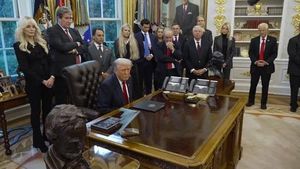As the 2025 election season heats up, a series of critical races across the country are putting the Democratic Party’s electoral strategy under the microscope. The big question: does moving leftward energize the base and draw in new voters, or does it risk alienating moderates and independents crucial for victory? Recent primaries, gubernatorial contests, and high-profile debates are offering fresh data—and plenty of drama—for both sides of the argument.
In New York, Zohran Mamdani’s win in the Democratic mayoral primary has reignited a debate that’s been simmering for decades. According to The Hill, Mamdani’s progressive platform—championing ideas like free child care, rent freezes for lower-income tenants, and a $30 minimum wage—struck a chord with voters. This victory has many party insiders asking: is the path to victory paved with bold, left-leaning policies, or is it safer to stick to the center?
History, as detailed by The Hill, paints a complicated picture. The Democratic Party’s biggest triumphs over the last century have often come during periods of progressive activism. Franklin Roosevelt’s New Deal in the 1930s and 1940s, for example, didn’t just bring sweeping economic reforms—it ushered in Democratic dominance in Congress for years. Similarly, the party’s embrace of the labor and civil rights movements in the 1950s and 1960s led to repeated electoral successes. When Democrats shifted toward the center—such as under Harry Truman in the late 1940s, or during the Clinton era in the 1990s—their grip on Congress wobbled or slipped altogether. Between 1992 and 2000, during Bill Clinton’s centrist leadership, Democrats lost control of both the Senate and the House, a fact that’s often overlooked in arguments for moderation.
“What they promoted turned out to be quite corrosive to the middle class. The Clinton people saw a need to moderate with centrist candidates. I don’t think that’s our issue. We need a compelling vision for the middle class of this country,” Senator Michael Bennet (D-Colo.) recently stated, as cited by The Hill. His remarks echo a growing sentiment among progressives: that the party’s future depends on offering tangible solutions to everyday economic challenges, not just playing it safe.
But is the leftward shift a guaranteed recipe for victory? Not everyone is convinced. A recent FiveThirtyEight/Ipsos poll, referenced by The Hill, found that while a quarter of eligible voters rarely or never cast a ballot, nearly half (44 percent) are only occasional voters. These episodically engaged and unengaged citizens represent a huge but unpredictable bloc. Many of them are younger, less wealthy, and less likely to identify with a political party—hardly a monolith, and not always ideologically motivated. Attracting them, analysts argue, requires more than rhetoric; it demands policies that visibly improve daily life.
Interestingly, when U.S. adults were polled about the kinds of progressive policies Mamdani supports—without knowing who was behind them—twice as many said they’d back a candidate with that platform as those who would not. This suggests that the substance of left-leaning proposals has broad appeal, even if the political branding sometimes doesn’t.
Yet, as Democrats debate their direction, the party faces tough battles in states that have long been considered strongholds. In New Jersey, the gubernatorial race between Democrat Mikie Sherrill and Republican Jack Ciattarelli is unexpectedly tight. Despite New Jersey’s blue reputation, polls show the two candidates running neck and neck, a development that has rattled Democrats nationwide. As Axios and The Week report, Sherrill’s campaign has been dogged by missteps—including a widely publicized struggle to answer questions about her family’s wealth in a May interview. This vulnerability has fueled a barrage of attack ads in what’s now the most expensive gubernatorial contest in New Jersey’s history, expected to top $200 million.
“Democrats will have a tough time nationally if we are struggling to even win a N.J. governorship while Trump has taken a wrecking ball to the government and Constitution,” Democratic strategist Irene Lin told The Week. The stakes are clear: a loss in New Jersey could signal deeper trouble for Democrats in the 2025 election cycle.
Adding to the intrigue, Republican nominee Jack Ciattarelli has doubled down on his support for former President Donald Trump, even as Trump’s favorability in New Jersey sits at just 41 percent. Ciattarelli’s gamble—refusing to criticize or distance himself from Trump—has left some observers scratching their heads. “Trump’s ‘One Big Beautiful Bill’ is good for all New Jerseyans,” Ciattarelli declared at a recent debate, according to MSNBC. Whether this loyalty pays off in a blue state remains to be seen.
The New Jersey race isn’t the only one grabbing headlines. In Virginia, the only debate between gubernatorial candidates Abigail Spanberger (Democrat) and Winsome Earle-Sears (Republican) was held at Norfolk State University and quickly turned heated. According to WWBT, the debate was marked by frequent interruptions and sharp exchanges. State Sen. Mark Peake, the Republican Party of Virginia Chairman, claimed Earle-Sears “mopped the floor with Abigail Spanberger,” while Democratic Party Chairman Lamont Bagby countered that Spanberger “did a fine job articulating her position” despite being repeatedly talked over.
University of Virginia political analyst Larry Sabato offered a more nuanced take. He observed that Earle-Sears’ aggressive style might not have landed well with independent voters—an essential group for any GOP upset in the state. Sabato also noted that Spanberger struggled with questions on abortion, gay marriage, and transgender locker room issues, and avoided commenting on whether Jay Jones should step aside as attorney general candidate after violent text messages emerged. “She basically gave policy-oriented answers. They were predictable. Nothing wrong with that, but nothing exciting,” Sabato said to WWBT.
Despite the fireworks, Sabato believes the debate likely won’t sway many voters before Election Day. Still, the event underscored the challenges facing both parties: Democrats must inspire and mobilize their base while reassuring swing voters, and Republicans have to find a way to expand their appeal without alienating moderates.
As the campaign season barrels toward November, Democrats face a crossroads. The historical record and recent polling, as reported by The Hill, suggest that progressive policies can galvanize support and deliver electoral wins. But the realities on the ground—in places like New Jersey and Virginia—show that execution, candidate appeal, and the unpredictable moods of the electorate matter just as much as ideology. For both parties, the next few weeks will be a test of not just policy, but persuasion and political instinct.
With high-profile races tightening and the national mood unsettled, the 2025 election is shaping up to be a pivotal moment for Democrats as they weigh whether to double down on their progressive roots or recalibrate for a broader coalition. The outcome will offer a telling verdict on which path leads to victory in a rapidly changing political landscape.




